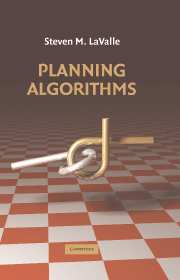13 - Differential Models
from IV - Planning Under Differential Constraints
Published online by Cambridge University Press: 21 August 2009
Summary
This chapter provides a continuous-time counterpart to the state transition equation, xk+1 = f(xk, uk), which was crucial in Chapter 2. On a continuous state space, X (assumed to be a smooth manifold), it will be defined as ẋ = f(x, u), which intentionally looks similar to the discrete version. It will still be referred to as a state transition equation. It will also be called a system (short for control system), which is a term used in control theory. There are no obstacle regions in this chapter. Obstacles will appear again when planning algorithms are covered in Chapter 14. In continuous time, the state transition function f(x, u) yields a velocity as opposed to the next state. Since the transitions are no longer discrete, it does not make sense to talk about a “next” state. Future states that satisfy the differential constraints are obtained by integration of the velocity. Therefore, it is natural to specify only velocities. This relies on the notions of tangent spaces and vector fields, as covered in Section 8.3.
This chapter presents many example models that can be used in the planning algorithms of Chapter 14. Section 13.1 develops differential constraints for the case in which X is the C-space of one or more bodies. These constraints commonly occur for wheeled vehicles (e.g., a car cannot move sideways). To represent dynamics, constraints on acceleration are needed.
Information
- Type
- Chapter
- Information
- Planning Algorithms , pp. 590 - 650Publisher: Cambridge University PressPrint publication year: 2006
Accessibility standard: Unknown
Why this information is here
This section outlines the accessibility features of this content - including support for screen readers, full keyboard navigation and high-contrast display options. This may not be relevant for you.Accessibility Information
- 2
- Cited by
